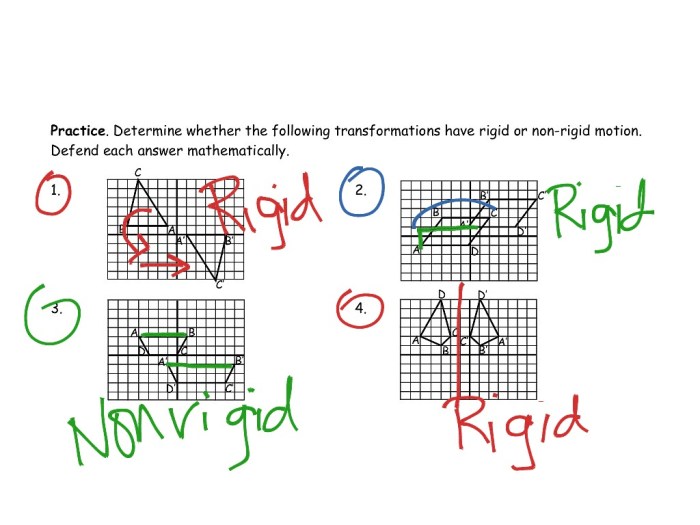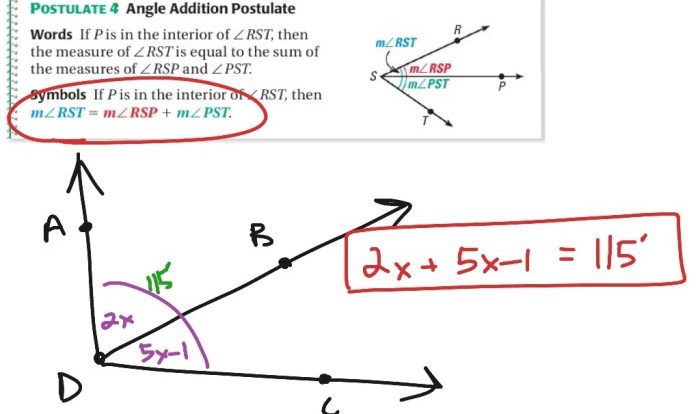Rigid motion transformation answer key unveils the fundamental concepts and applications of rigid motion transformations, providing a thorough understanding of their significance in various fields. These transformations play a pivotal role in computer graphics, robotics, engineering, and more, enabling precise manipulation and analysis of objects in both physical and virtual environments.
From exploring the types of rigid motion transformations, including translation, rotation, and reflection, to delving into their mathematical representation through homogeneous transformation matrices, rotation matrices, and translation vectors, this answer key offers a comprehensive overview of the subject matter. Its concise explanations, clear examples, and insightful discussions empower learners to grasp the intricacies of rigid motion transformations and their practical applications.
1. Rigid Motion Transformations

Rigid motion transformations are a set of transformations that preserve the distance and angle between any two points in a figure. They are used to move, rotate, and reflect figures in a plane or in space.
Examples of rigid motion transformations include:
- Translation: Moving a figure from one point to another without changing its orientation.
- Rotation: Turning a figure around a fixed point.
- Reflection: Flipping a figure over a line.
Rigid motion transformations have the following properties:
- They preserve the distance between any two points in a figure.
- They preserve the angle between any two lines in a figure.
- They are invertible.
2. Types of Rigid Motion Transformations
Translation
Translation is a rigid motion transformation that moves a figure from one point to another without changing its orientation.
Examples of translation include:
- Moving a chair from one side of a room to another.
- Sliding a book across a table.
- Rolling a ball down a hill.
Translation has the following properties:
- It preserves the distance between any two points in a figure.
- It preserves the angle between any two lines in a figure.
- It is invertible.
Rotation
Rotation is a rigid motion transformation that turns a figure around a fixed point.
Examples of rotation include:
- Turning a steering wheel.
- Spinning a top.
- Rotating a planet around the sun.
Rotation has the following properties:
- It preserves the distance between any two points in a figure.
- It preserves the angle between any two lines in a figure.
- It is invertible.
Reflection
Reflection is a rigid motion transformation that flips a figure over a line.
Examples of reflection include:
- Looking in a mirror.
- Folding a piece of paper in half.
- Bouncing a ball off a wall.
Reflection has the following properties:
- It preserves the distance between any two points in a figure.
- It preserves the angle between any two lines in a figure.
- It is invertible.
3. Applications of Rigid Motion Transformations, Rigid motion transformation answer key
Computer Graphics
Rigid motion transformations are used in computer graphics to move, rotate, and scale objects in a 3D scene.
Examples of how rigid motion transformations are used in computer graphics include:
- Animating a character walking across a room.
- Rotating a camera around an object.
- Scaling a model to fit a particular space.
Robotics
Rigid motion transformations are used in robotics to control the movement of robots.
Examples of how rigid motion transformations are used in robotics include:
- Moving a robot arm to pick up an object.
- Rotating a robot’s head to look around.
- Translating a robot from one location to another.
Engineering
Rigid motion transformations are used in engineering to design and analyze structures.
Examples of how rigid motion transformations are used in engineering include:
- Calculating the forces on a bridge.
- Designing a new machine.
- Analyzing the stability of a structure.
4. Mathematical Representation of Rigid Motion Transformations
Homogeneous Transformation Matrix
A homogeneous transformation matrix is a 4×4 matrix that represents a rigid motion transformation in 3D space.
The homogeneous transformation matrix is given by:
$$T = \beginbmatrixr_11 & r_12 & r_13 & t_x \\r_21 & r_22 & r_23 & t_y \\r_31 & r_32 & r_33 & t_z \\
& 0 & 0 & 1
\endbmatrix$$
where:
- $r_ij$ is the element in the ith row and jth column of the rotation matrix.
- $t_x$, $t_y$, and $t_z$ are the x, y, and z components of the translation vector.
Rotation Matrix
A rotation matrix is a 3×3 matrix that represents a rotation around a fixed axis.
The rotation matrix is given by:
$$R = \beginbmatrix\cos \theta &
\sin \theta & 0 \\
\sin \theta & \cos \theta & 0 \\
& 0 & 1
\endbmatrix$$
where $\theta$ is the angle of rotation.
Translation Vector
A translation vector is a 3×1 matrix that represents a translation in 3D space.
The translation vector is given by:
$$t = \beginbmatrixt_x \\t_y \\t_z\endbmatrix$$
where $t_x$, $t_y$, and $t_z$ are the x, y, and z components of the translation vector.
Helpful Answers: Rigid Motion Transformation Answer Key
What are the three main types of rigid motion transformations?
Translation, rotation, and reflection.
How are rigid motion transformations used in computer graphics?
To manipulate and animate objects in 3D space.
What is the difference between a rotation matrix and a translation vector?
A rotation matrix represents a rotation transformation, while a translation vector represents a translation transformation.




